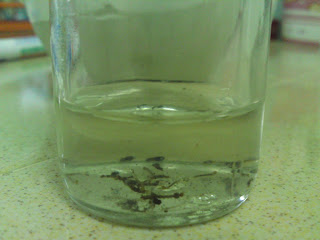Date : 19 January 2012 (Thursday)
Time: 8.30 – 11.00 am
We were scheduled for another day of disease control session.Upon arrival, we were being fed with information regarding TB, HIV/AIDS as well as Aedes larvae species identification in the laboratory.
A. Tuberculosis
PKD Zadi updated us with informations regarding TB department.
Objectives:
1. Notification
- This can be done via online notification or the hard copy form entry (10A-1) by doctors to PKD
- Normally done after positive lab results of sputum positive
2. Registration
-PKD then will investigate and register accordingly into either:
1. Pulmonary +ve ( Infectious )
2. Pulmonary –ve ( Non infectious: sputum –ve but X-ray +ve )
3.Extrapulmonary (Non infectious: Presence of bacteria but couldn’t be excreted by coughing )
3.Treatment
- Here, a 6 month treatment plan is followed:
2 month of intensive medication --> Sputum –ve --> Once 1 weekly
There is two type of centres for treatment:
Pusat Rawatan 1 whereby investigation such as X-ray and laboratory confirmation can be done and thus, starting a treatment plan. Only Hospital Jitra and KK Changlun are PR1 in this district.
Pusat Rawatan 2 is where treatment plan can be started but only continued. More like following up for treatment plan arranged earlier.
4. Disease control
- Contact tracing is a must after every notification as this will help to control the spread of TB to others.
- We were being enlightened with the fact that UV light is able to kill the TB bacteria. Therefore, all windows In the house will be opened upon home visitations as most of the TB patients live in the dark.
Below are the TB case records for 2011:
We were informed that there was an increase of 2 cases in 2011 (100 cases) compared to 2010 (98 cases) and most of the patients were elderly more than 60years old.
However, there isn’t any programs deliberate yet for TB control in this DHO.
B. HIV/AIDS/STI
This session was taken by PKD Razali and we were shortly briefed about HIV and AIDS and their differences.
Obejectives:
1. Notification
- Similar to the TB department, notification can be done through e-notification and also an investigation form from the National AIDS Registry (NAR)
- only after 2 positive results
-mostly from hospital and also screening programs
2. Source identification
- Upon notification, patient will then be contacted and a home visit will be done
- This is when the source of HIV/AIDS can be identified
3.Registration
- After source identification, this will be followed by system input and registration by PKD to State Health Department Putrajaya
- Registration can be categorized into either HIV,AIDS and death.
4. HIV Management programs
- Anonymous Screening Program
-Screening test done without the need of giving names
-Pre-married couples, pregnant mothe
-Needle Sharing Exchange Program
- Only in KK Ayer Itam
- A set of 8 needles were given to the drug user and new needles can be exchanged
depending on the amount of needles returned by the same drug use
- So far 2 persons were on this program in year 2010 only.
- HIV talks given by doctors
-Counseling
-Most of these programs are targeted to high risk groups like teens, homosexuals as well as drug abusers.
5. Corpse Management
-DHO is responsible to train around 100 people to deal with this matte
-Collaboration with AADK ( Religion office )
- Trained personnel will be aware of the safety precautions taken before handling the corpse which includes equipment protections
- Normally, washing of the body with sodium hypocloride (Dilution 1:10) will be the first and last procedure.
*Data for year 2008 was still recorded as total cases and wasn’t recorded separatively
C. Aedes Larvae Identification
We were divided into smaller groups and brought into the laboratory where mosquito larvae can be identified microscopically. The larvae will first be preserved in 70% ethanol and then be viewed under 10x megapixel microscope. We were taught that the larvae can be divided into head, thorax, abdomen and siphon.The abdomen can be further divided into smaller divisions and to identify the different species, we were given the chance to look at the 8th division of the abdomen for the different types of spine under the microscope. Today's session was dismissed around 11am after all the information loading.
Reported by,
Loh Sue Anne











No comments:
Post a Comment